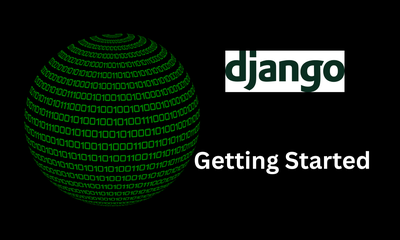Learn Django in 14 days - Day 3: Admin Interface
By JoeVu, at: June 16, 2023, 11:44 a.m.
Estimated Reading Time: __READING_TIME__ minutes


Learn Django in 14 days - Day 3: Admin Interface
In the previous article, we covered the basics of Django models and databases. Now, it's time to explore another essential component of Django development: the admin interface. Django's admin interface provides a convenient way to manage and manipulate data stored in your models without having to write extensive code. Let's dive into Day 3 of our Django learning journey and discover the power of the Django Admin!
1. Introduction to Django Admin
Django Admin is a built-in module that offers a user-friendly interface for managing your application's data. It automatically generates a customizable administration area based on your models, allowing you to perform various administrative tasks with ease.
There will be more advance topics at the end.
The sample source code can be found here
2. Registering models in the admin
To make your models accessible through the admin interface, you need to register them. This step involves creating an admin.py file within your app and defining the registration code.
Creating an admin.py file
Start by creating an admin.py file in your app's directory if it doesn't already exist. This file will contain the necessary code to register your models in the admin.
Normally, when you run the command python manage.py startapp, this commands automatically create file admin.py with the content below
from django.contrib import admin
# Register your models here.
Registering models
Within the admin.py file, import your models and use the admin.site.register() method to register them. This step enables you to view, create, update, and delete objects of your models through the admin interface.
from django.contrib import admin
from store.models import Author
@admin.register(Author)
class AuthorAdmin(admin.ModelAdmin):
list_display = ("name", "date_of_birth", "country")
Customizing the admin interface
Django Admin allows you to customize the appearance and behavior of the admin interface. You can define custom admin classes that inherit from admin.ModelAdmin and override various methods to modify how your models are displayed and interacted with in the admin.
from django.contrib import admin
from store.models import Author
@admin.register(Author)
class AuthorAdmin(admin.ModelAdmin):
list_display = ("name", "date_of_birth", "country")
3. Managing data through the admin
The Django Admin interface provides a comprehensive set of tools for managing your data efficiently.
Creating, updating, and deleting objects
Through the admin interface, you can create new objects by filling in the required fields. You can also update existing objects by editing their attributes or delete them if necessary.
Search and filtering options
The admin interface offers search and filtering capabilities, allowing you to quickly find specific objects based on specific criteria. This feature becomes invaluable as your data grows.
Bulk actions
Django Admin enables you to perform bulk actions on multiple objects simultaneously. You can select multiple objects and apply common actions such as deletion or updating in a single operation.
4. Permissions and user management
Django Admin provides built-in functionality for managing permissions and user access to the admin interface.
Assigning permissions
You can assign specific permissions to user groups or individual users, controlling their level of access and actions they can perform within the admin interface.
Creating superusers
Superusers have full access and control over the admin interface and can perform any administrative task. Django provides a simple command to create superusers, ensuring only authorized individuals have elevated privileges.
Or you can run the command python manage.py createsuperuser
Customizing user authentication
You have the flexibility to integrate custom authentication mechanisms and user models with the Django Admin interface, allowing you to enforce your own user management policies and authentication methods.
5. Customizing the admin interface
Django Admin offers various options for customizing the appearance and behavior of the admin interface to match your application's specific requirements.
Model admin options
You can customize individual model admin classes to modify the behavior and appearance of specific models within the admin interface. This includes defining list views, detail views, fieldsets, and more.
Inline models
Inline models allow you to display related models within the parent model's edit view. This feature is particularly useful when dealing with models that have one-to-many or many-to-many relationships.
Customizing list and detail views
You can customize the list and detail views of your models in the admin interface by defining methods and properties within the model admin class. This allows you to control the displayed information and add additional functionality.
6. Security considerations
When working with the Django Admin interface, it's important to consider security measures to protect your application and sensitive data.
Securing the admin interface
Apply appropriate security measures to protect the admin interface from unauthorized access. This includes restricting access through authentication mechanisms, ensuring secure login processes, and utilizing HTTPS encryption.
Limiting access and permissions
Grant admin access and permissions only to authorized individuals. Regularly review and update user permissions to ensure that they align with the required level of access for administrative tasks.
Protecting against common vulnerabilities
Stay informed about common security vulnerabilities and apply necessary security patches and updates to keep your Django installation secure. Implement best practices such as input validation, protecting against cross-site scripting (XSS), and preventing SQL injection attacks.
7. Advance topics
7.1 Customize Admin Interface
Templates: Django Admin uses default templates to render the admin interface, but you can override these templates to customize the HTML structure and appearance. By creating your own templates and overriding the default ones, you have full control over the layout, styling, and even the inclusion of additional JavaScript or CSS.
Custom CSS and JavaScript: In addition to customizing the admin interface through templates, you can also add custom CSS or JavaScript files to modify the styling and behavior. This gives you the flexibility to apply custom styles, add interactivity, or integrate third-party libraries.
Admin Site Theming: If you want to change the overall look and feel of the admin interface, you can create a custom theme by overriding the default admin site templates, CSS, and images. This allows you to align the admin interface with your application's branding and design guidelines.
Take a look here django/contrib/admin/templates
Useful packages:
7.2 Customize Admin Model Form
ModelForm Class: Django Admin automatically generates a form for each model registered in the admin interface. To customize the form, you can create a ModelForm class that inherits from django.forms.ModelForm and define the desired modifications.
Form Validation: Django provides a built-in form validation mechanism that automatically validates form data based on the field types and constraints defined in the model. Additionally, you can add custom validation logic by defining a clean() method in the ModelForm class. This allows you to enforce specific business rules or perform complex validations.
Form Layout: Django Admin uses a default layout for rendering the admin model form, but you can customize the form's HTML structure and appearance by overriding the default templates. By creating custom templates, you have full control over the layout, styling, and inclusion of additional HTML, CSS, or JavaScript.
Inline Model Formsets: In Django Admin, you can also customize the forms used in inline model formsets. Inline formsets are used when you have models with related one-to-many or many-to-many relationships, and you want to manage them together. You can customize the inline model formsets to control the fields displayed, field ordering, and validation.
For examples
from django import forms
from .models import Author
class AuthorForm(forms.ModelForm):
def __init__(self, *args, **kwargs):
print("My custom admin Form")
super().__init__(*args, **kwargs)
class Meta:
fields = ('name', 'title', 'birth_date')=======================================================================
from django.contrib import admin
from .models import Author
from .forms import AuthorForm
class AuthorAdmin(admin.ModelAdmin):
form = AuthorForm
admin.site.register(Author, AuthorAdmin)
Useful packages:
7.3 Customize Widgets
Widget Class: In Django, widgets are represented by Python classes that define how form fields are rendered in HTML. To create a custom widget, you can define a subclass of django.forms.Widget or use existing widget classes provided by Django or third-party packages.
Customizing Field Presentation: You can use custom widgets to change how fields are presented in the admin interface. For example, you can use a date picker widget to replace the default text input for a DateField or use a rich text editor widget for a TextField.
Widget Options and Attributes: Widgets often have configurable options and attributes that control their behavior and appearance. For instance, you can customize the format of a date picker widget or specify the available choices for a select widget.
Custom Widget Templates: In addition to customizing the widget class, you can also override the widget template to modify its HTML structure and appearance. By creating a custom template, you have full control over how the widget is rendered, allowing you to apply custom styles or include additional elements.
Widget Validation: Custom widgets can also handle client-side and server-side validation for the associated fields. You can define validation logic within the widget class or use the built-in validation mechanisms provided by Django.
Widget Media Assets: Some custom widgets may require additional CSS or JavaScript assets to function properly. Django provides a mechanism to manage these assets and include them in the rendered admin interface. By specifying the Media class within the custom widget, you can include the required assets and ensure their proper loading.
Useful packages:
7.4 Best Practices
-
Separate Admin Configuration: It's good practice to keep your admin configuration separate from your models. Create a separate file (e.g., admin.py) where you register models and define ModelAdmin classes. This keeps your code organized and makes it easier to manage and maintain.
-
ModelAdmin Inheritance: Use model inheritance and subclassing to avoid code duplication in your ModelAdmin classes. If you have multiple models with similar admin configurations, create a base ModelAdmin class and subclass it for each specific model.
-
Customizing Templates: When customizing admin templates, it's best to override specific templates rather than creating a complete set of custom templates. This approach ensures that your customizations stay in sync with future updates to Django Admin and reduces the risk of breaking changes.
-
Form Customization: For more complex forms, use ModelForm or Form classes to customize the form behavior. This allows you to add custom validation, modify field ordering, or include additional form fields not directly related to the model.
-
Custom Actions: When defining custom actions, ensure they're idempotent and don't have unintended side effects. Actions should clearly communicate their purpose and be designed to handle bulk operations efficiently.
-
Permissions and Authorization: Leverage Django's built-in permission system to control access to admin views and actions. Assign appropriate permissions to user groups or individual users based on their roles and responsibilities.
-
Utilize InlineModelAdmin: Use InlineModelAdmin to manage related models within the admin interface. This simplifies the user experience and allows for easy editing and creation of related objects.
-
Testing: Write tests for your custom admin code to ensure it behaves as expected. Test not only the basic functionality but also edge cases and validation logic to maintain the stability of your custom admin configurations.
-
Maintain Readability: Write clean and readable code by following the PEP 8 style guide. Use meaningful variable and method names, add comments where necessary, and break down complex logic into smaller, reusable functions.
-
Leverage Third-Party Packages: Django has a rich ecosystem of third-party packages that provide additional functionality and enhancements for the admin interface. When appropriate, leverage these packages to extend the capabilities of Django Admin rather than reinventing the wheel.
-
Documentation: Document your custom admin configurations, including any specific customizations, rationale behind design choices, and any instructions or guidelines for other developers working on the project. This is controversal as developers do not usually update documentation with new code changes.
8. Conclusion
In this article, we explored the Django Admin interface, an essential tool for managing data in your Django applications. We learned how to register models, customize the admin interface, manage data, handle permissions and user management, customize the interface appearance and behavior, support internationalization, and ensure security. With Django Admin, you can efficiently manage your application's data without writing extensive code, saving valuable development time.
FAQs
Q1: Can I customize the Django Admin interface's appearance with my own CSS?
Yes, you can customize the appearance of the Django Admin interface by providing your own CSS styles. Django allows you to override the default admin templates and apply custom styling to match your application's design.
Q2: Can I limit access to certain models or admin functionality for specific user groups?
Yes, Django Admin provides fine-grained control over user permissions. You can define custom admin classes, restrict access to certain models or admin functionality, and assign specific permissions to user groups or individual users.
Q3: Is it possible to integrate third-party libraries or plugins with the Django Admin interface?
Yes, Django Admin supports integration with third-party libraries and plugins. Many Django packages provide additional functionality and features that can be seamlessly integrated into the admin interface to extend its capabilities.
Q4: Can I use the Django Admin interface for non-technical users?
Yes, the Django Admin interface is designed to be user-friendly and intuitive. With proper configuration and customization, you can make it accessible to non-technical users, allowing them to manage data and perform administrative tasks with minimal technical knowledge.
Q5: Can I create custom admin views or pages within the Django Admin interface?
Yes, Django allows you to create custom admin views or pages to fulfill specific requirements. You can define your own admin views and associate them with custom URLs, providing additional functionality within the admin interface.
Q6: Does Django Admin support authentication through third-party services like OAuth?
Yes, Django provides integrations with third-party authentication services like OAuth. You can configure Django to use OAuth authentication, allowing users to log in to the admin interface using their existing social media or identity provider accounts.
Reference:




